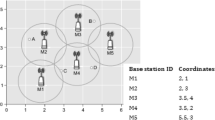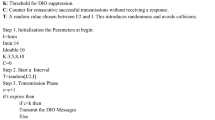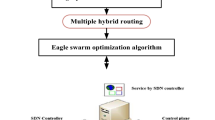Abstract
Clustering could be one of the important approaches in saving energy and load balancing in IoT networks with high density. This paper uses these two factors to improve the network performance and network routing scheme. This paper proposes a Double Leveled Unequal Clustering routing protocol in which traffic load is shared among cluster members to reduce the energy consumption and dropping probability in crucial nodes by sending packets independent of cluster head. A new clustering approach is also proposed that optimally creates unequal-sized clusters with the lowest common spaces between clusters to reduce the number of cluster heads. This approach aims to fulfill the following purposes: decrease the number of clusters to reduce the number of cluster heads and thus reduce the load on crucial nodes, reduce the energy consumption with optimizing the created clusters, optimize the channel bandwidth usage, reduce the interference between control packets by avoiding congestion using framing times, control the redundant control packets by descending the number of reclusterings, and decrease the drop timeout (i.e., whether a packet can wait for a time duration to be sent. If it cannot wait, it will be dropped automatically) by simultaneous transmissions as well as drop of interference by utilizing multi-channel approach. In addition, nodes can turn off their radios in the semi-sleep mode for saving their energy within their idle times. In this way, overall lifetime of the network can be increased by enhancing lifetime of the nodes. According to simulation results, under the proposed approach, throughput of the network increases while the energy consumption decreases due to less reclustering.















Similar content being viewed by others
References
Palattella, M. R., Accettura, N., Vilajosana, X., Watteyne, T., Grieco, L. A., Boggia, G., et al. (2013). Standardized protocol stack for the internet of (important) things. IEEE Communications Surveys & Tutorials, 15, 1389–1406.
Bello, O., & Zeadally, S. (2016). Intelligent device-to-device communication in the internet of things. IEEE Systems Journal, 10, 1172–1182.
Ashton, K. (2009). That ‘internet of things’ thing. RFID Journal, 22, 97–114.
Dhumane, A., Prasad, R., & Prasad, J. (2016). Routing issues in internet of things: A survey. In Proceedings of the international multiconference of engineers and computer scientists (pp. 16–18).
Díaz, M., Martín, C., & Rubio, B. (2016). State-of-the-art, challenges, and open issues in the integration of Internet of things and cloud computing. Journal of Network and Computer Applications, 67, 99–117.
Misra, S., Maheswaran, M., & Hashmi, S. (2017). Securing the Internet of Things. In Security challenges and approaches in Internet of Things (pp. 39–51). Berlin: Springer.
Guo, B., Zhang, D., Wang, Z., Yu, Z., & Zhou, X. (2013). Opportunistic IoT: Exploring the harmonious interaction between human and the internet of things. Journal of Network and Computer Applications, 36, 1531–1539.
Gubbi, J., Buyya, R., Marusic, S., & Palaniswami, M. (2013). Internet of Things (IoT): A vision, architectural elements, and future directions. Future Generation Computer Systems, 29, 1645–1660.
Kong, L., Xiang, Q., Liu, X., Liu, X.-Y., Gao, X., Chen, G., et al. (2016). ICP: Instantaneous clustering protocol for wireless sensor networks. Computer Networks, 101, 144–157.
Shen, J., Shen, J., Chen, X., Huang, X., & Susilo, W. (2017). An efficient public auditing protocol with novel dynamic structure for cloud data. IEEE Transactions on Information Forensics and Security, 12, 2402–2415.
Shen, J., Zhou, T., He, D., Zhang, Y., Sun, X., & Xiang, Y. (2017). Block design-based key agreement for group data sharing in cloud computing. IEEE Transactions on Dependable and Secure Computing, 14, 1–15.
Corke, P., Wark, T., Jurdak, R., Hu, W., Valencia, P., & Moore, D. (2010). Environmental wireless sensor networks. Proceedings of the IEEE, 98, 1903–1917.
Atzori, L., Iera, A., & Morabito, G. (2010). The internet of things: A survey. Computer Networks, 54, 2787–2805.
Skarmeta, A. F., Hernandez-Ramos, J. L., & Moreno, M. V. (2014). A decentralized approach for security and privacy challenges in the internet of things. In 2014 IEEE world forum on Internet of Things (WF-IoT) (pp. 67–72).
Sicari, S., Cappiello, C., De Pellegrini, F., Miorandi, D., & Coen-Porisini, A. (2016). A security-and quality-aware system architecture for Internet of Things. Information Systems Frontiers, 18, 665–677.
Nokhanji, N., Hanapi, Z. M., Subramaniam, S., & Mohamed, M. A. (2015). An energy aware distributed clustering algorithm using fuzzy logic for wireless sensor networks with non-uniform node distribution. Wireless Personal Communications, 84, 395–419.
Kaur, P. J. (2015). A survey of clustering techniques and algorithms. In 2015 2nd international conference on computing for sustainable global development (INDIACom) (pp. 304–307).
Heinzelman, W. R., Chandrakasan, A., & Balakrishnan, H. (2000). Energy-efficient communication protocol for wireless microsensor networks. In Proceedings of the 33rd annual Hawaii international conference on system sciences, 2000 (Vol. 2, p. 10).
Yektaparast, A., Nabavi, F.-H., & Sarmast, A. (2012). An improvement on LEACH protocol (Cell-LEACH). In 2012 14th international conference on advanced communication technology (ICACT) (pp. 992–996).
Lung, C.-H., & Zhou, C. (2010). Using hierarchical agglomerative clustering in wireless sensor networks: An energy-efficient and flexible approach. Ad Hoc Networks, 8, 328–344.
Guo, P., Wang, J., Geng, X. H., Kim, C. S., & Kim, J.-U. (2014). A variable threshold-value authentication architecture for wireless mesh networks. Airiti Library, 15, 929–935.
Marappan, P., & Rodrigues, P. (2016). An energy efficient routing protocol for correlated data using CL-LEACH in WSN. Wireless Networks, 22, 1415–1423.
Shen, J., Wang, A., Wang, C., Ren, Y., & Wang, J. (2015). Performance comparison of typical and improved LEACH protocols in wireless sensor network. In 2015 first international conference on computational intelligence theory, systems and applications (CCITSA) (pp. 187–192).
Lin, D., & Wang, Q. (2017). A game theory based energy efficient clustering routing protocol for WSNs. Wireless Networks, 23, 1101–1111.
Razaque, A., Mudigulam, S., Gavini, K., Amsaad, F., Abdulgader, M., & Krishna, G. S. (2016). H-LEACH: Hybrid-low energy adaptive clustering hierarchy for wireless sensor networks. In Systems, applications and technology conference (LISAT), 2016 IEEE Long Island (pp. 1–4).
Razaque, A., Abdulgader, M., Joshi, C., Amsaad, F., & Chauhan, M. (2016). P-LEACH: Energy efficient routing protocol for wireless sensor networks. In Systems, applications and technology conference (LISAT), 2016 IEEE Long Island (pp. 1–5).
Rana, S., Bahar, A. N., Islam, N., & Islam, J. (2015). Fuzzy based energy efficient multiple cluster head selection routing protocol for wireless sensor networks. International Journal of Computer Network and Information Security, 4, 54–61.
Yi, D., & Yang, H. (2016). HEER—A delay-aware and energy-efficient routing protocol for wireless sensor networks. Computer Networks, 104, 155–173.
Shah, S. B., Chen, Z., Yin, F., Khan, I. U., & Ahmad, N. (2018). Energy and interoperable aware routing for throughput optimization in clustered IoT-wireless sensor networks. Future Generation Computer Systems, 81, 372–381.
Gajjar, S., Sarkar, M., & Dasgupta, K. (2016). FAMACROW: Fuzzy and ant colony optimization based combined mac, routing, and unequal clustering cross-layer protocol for wireless sensor networks. Applied Soft Computing, 43, 235–247.
Fouladlou, M., & Khademzadeh, A. (2017). An energy efficient clustering algorithm for wireless sensor devices in Internet of Things. Artificial Intelligence and Robotics (IRANOPEN), 2017, 39–44.
Qing, L., & Cong, L. (2016). Efficient cluster routing design under the environment of Internet of Things based on location. In 2016 international conference on intelligent transportation, big data & smart city (ICITBS) (pp. 318–323).
Li, D.-A., Hao, H., Ji, G., & Zhao, J. (2015). An adaptive clustering algorithm based on improved particle swarm optimisation in wireless sensor networks. International Journal of High Performance Computing and Networking, 8, 370–380.
Kumar, N., Tyagi, S., & Deng, D.-J. (2014). LA-EEHSC: Learning automata-based energy efficient heterogeneous selective clustering for wireless sensor networks. Journal of Network and Computer Applications, 46, 264–279.
Tang, J., Zhou, Z., Niu, J., & Wang, Q. (2014). An energy efficient hierarchical clustering index tree for facilitating time-correlated region queries in the Internet of Things. Journal of Network and Computer Applications, 40, 1–11.
Yilmaz, O., Dagdeviren, O., & Erciyes, K. (2014). Localization-free and energy-efficient hole bypassing techniques for fault-tolerant sensor networks. Journal of Network and Computer Applications, 40, 164–178.
Peng, L., Dong, G.-Y., Dai, F.-F., & Liu, G.-P. (2014). A new clustering algorithm based on ACO and K-medoids optimization methods. IFAC Proceedings Volumes, 47, 9727–9731.
Chang, J.-Y., & Ju, P.-H. (2014). An energy-saving routing architecture with a uniform clustering algorithm for wireless body sensor networks. Future Generation Computer Systems, 35, 128–140.
Arunraja, M., Malathi, V., & Sakthivel, E. (2015). Energy conservation in WSN through multilevel data reduction scheme. Microprocessors and Microsystems, 39, 348–357.
Gherbi, C., Aliouat, Z., & Benmohammed, M. (2016). An adaptive clustering approach to dynamic load balancing and energy efficiency in wireless sensor networks. Energy, 114, 647–662.
Author information
Authors and Affiliations
Corresponding author
Additional information
Publisher's Note
Springer Nature remains neutral with regard to jurisdictional claims in published maps and institutional affiliations.
Rights and permissions
About this article
Cite this article
Farahani, M., Ghaffarpour Rahbar, A. Double Leveled Unequal Clustering with Considering Energy Efficiency and Load Balancing in Dense IoT Networks. Wireless Pers Commun 106, 1183–1207 (2019). https://doi.org/10.1007/s11277-019-06209-0
Published:
Issue Date:
DOI: https://doi.org/10.1007/s11277-019-06209-0




